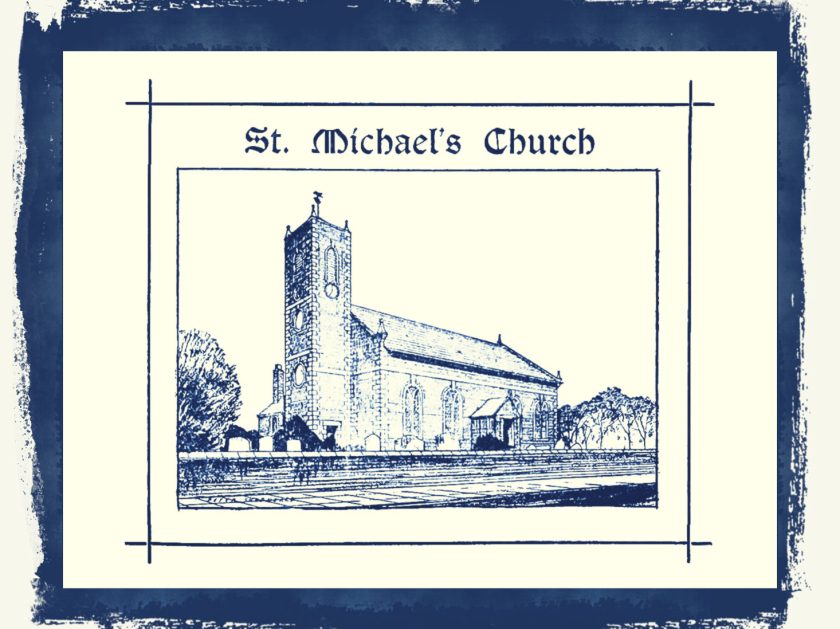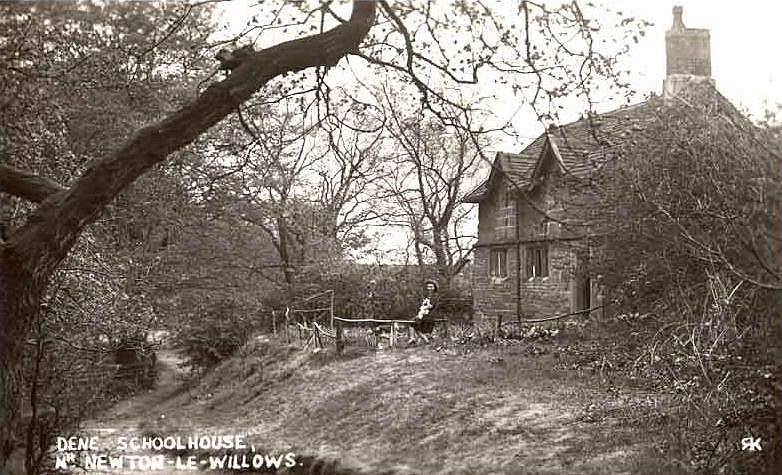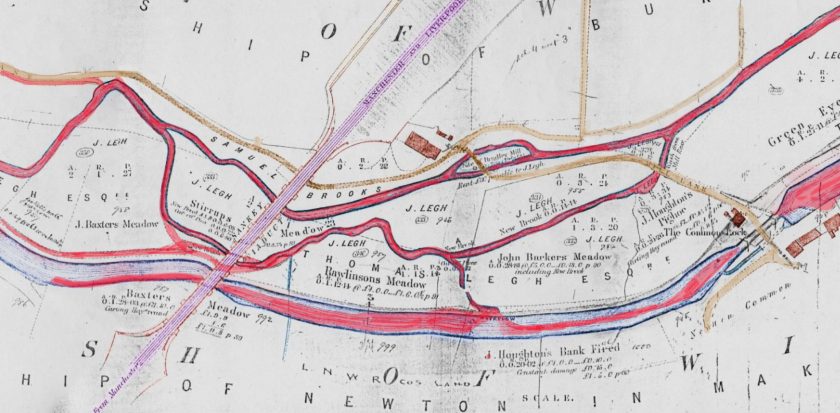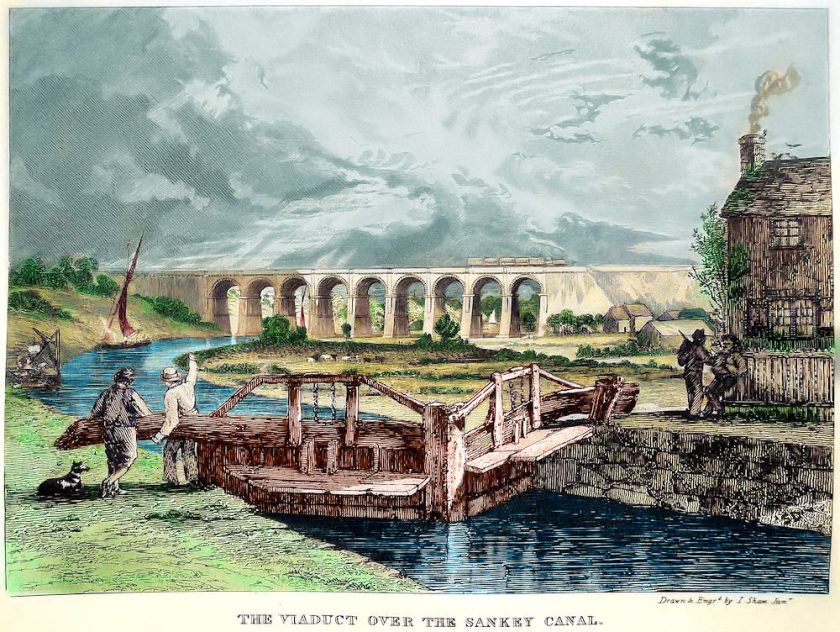St. Michael’s Church, Burtonwood. 1716 – 1939
This Book is dedicated to the Glory of Almighty God as a special means of expressing the grateful thanks of the Parishioners of Burtonwood, for the realisation of their desire in the completion of the Restoration and Enlargement of St. Michael’s Church on St. Michael’s and All Angels Day, 1939.
St. Michael’s Church
RESTORATION AND ENLARGEMENT COMMITTEE, 1939.
Chairman: The Vicar, Rev. Thomas Cowing, M.C., M.M.
Treasurers: Thos. Forshaw, Esq., John Gleave, Esq.
Secretary: C. V. Smith, Esq., M.M.
Architect: E. J. Dod, Esq., A.R.I.B.A. Diocesan Surveyor, Liverpool.
Vicar: Rev. THOMAS COWING, M.C., M.M.
Officers of the Church, 1939.
Churchwardens: Mr. C. V. Smith, M.M., Mr. James Fairclough.
Organist and Choir-Mistress: Mrs. F. E. Cowing.
Sidesmen: Mr. J. Addison, Mr. J. Forshaw, Mr. J. Gleave, Mr. W. Greenwood, Mr. W. Roberts, Mr. M. Heyes, Mr. H. Helsby, Mr. R. Fairclough, Mr. R. Holland, Mr. F. Brown, Mr. S. Cooper, Mr. L. Spurling, Mr. G. Spurling, Mr. J. D. Jones, Mr. W. Rimmer, Mr. E. Naylor, Mr. N. Fairclough.
Parochial Church Council
Secretary: Mr. F. Brown, The Vicar, The Wardens, Mrs. Cowing, Mrs. J. Jones, Mrs. D. Jones, Miss E. Gleave, Mrs. L. Smith, Mr. J. Gleave, Mr. T. Forshaw, Mr. M. Heyes, Mr. W. Greenwood, Mr. R. Fairclough.
Mothers’ Union
Presiding Member: Mrs. F. E. Cowing.
Secretary-Treasurer: Mrs. J. Jones.
Sunday School—Superintendent: Mrs. Cowing.
Secretary: Miss E. Gleave.
Boys’ Brigade: Chaplain-The Vicar.
Life Boys: Captain: Mr. W. Greenwood.
Girls’ Brigade: Captain: Mrs. Cowing. Lieut.: Miss E. Gleave.
Young People Fellowship: Captain Mr. R. Fairclough.
Verger: Mr. R. Roberts.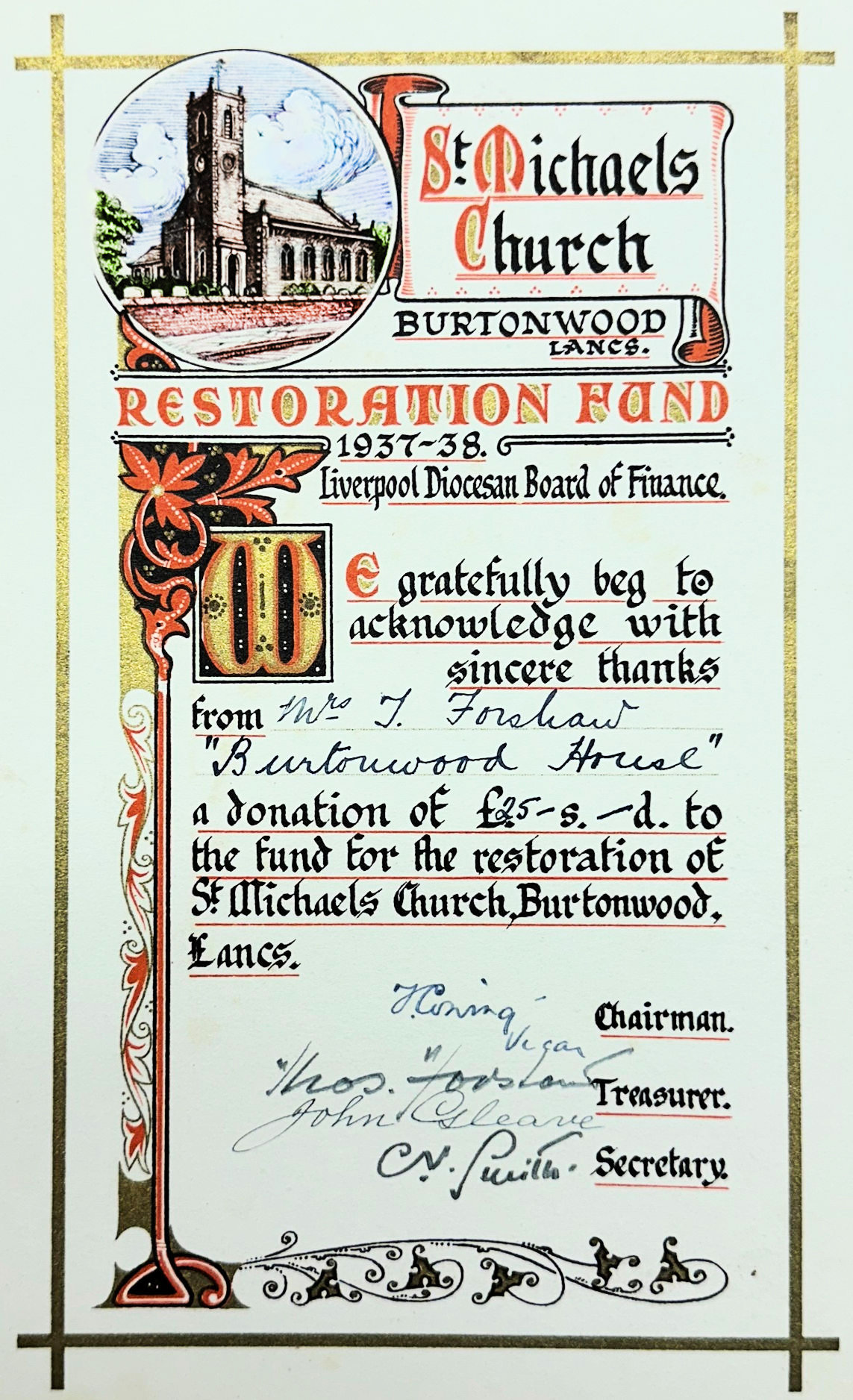
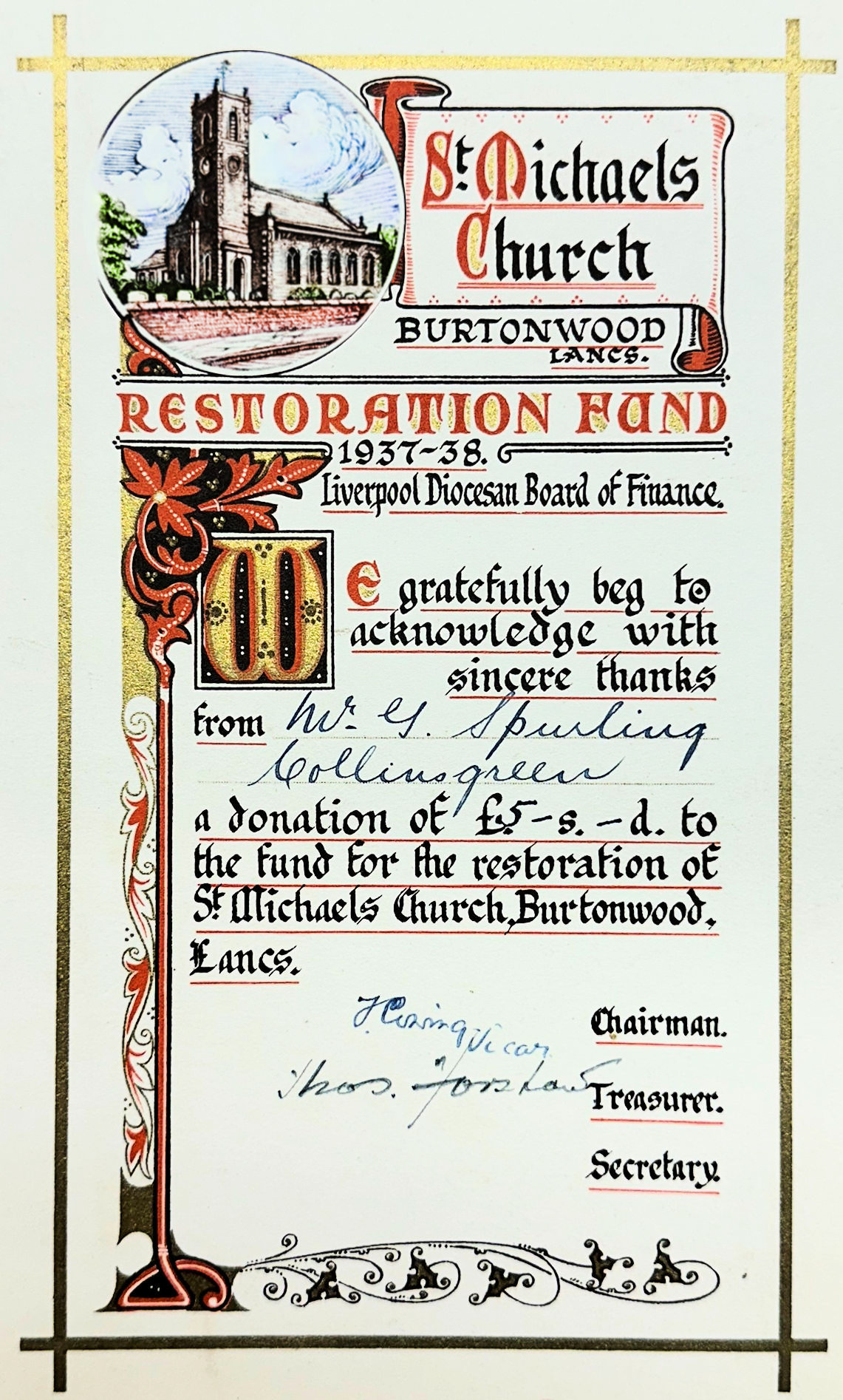
St. Michael’s Church, Burtonwood
A SHORT HISTORY.
The Chapel of Burtonwood was founded by Sir Thos. Bold by a deed of feoffment, dated 27th September, 1605. He conveyed a portion of land in trust from the Waste in Burtonwood, 40 roods in length and 20 roods in breadth. The rent charge to be one penny annually to him and his heirs on the Natal feast of St. John the Baptist.
It appears by the proceedings of a Commission AD.PIUS. USUS. before John Bishop of Chester on an inquisition taken at Wigan, March 28th, 1627;
That Thomas Darbishire of Burtonwood, Yeoman BY WILL dated 23rd January 44 Elizabeth 1586, had designed to found a Chapel at Windybanks in Burtonwood, and for this purpose bequeathed to trustees (three-score pounds, £60) to purchase land or a rent charge for the maintenance of a Minister or Reader.
The jurors of the above inquisition found that a Chapel or House of Prayer had existed there for 20 years or more according to the intent of the testator Thomas Darbishire.
The site called “Windy Bank” was given by Sir Thomas Bold in 1605 (James I) who married Bridget Norres of Speke Hall. This gift may have been influenced by the fact that Richard Bancroft, Bishop of London, and later Archbishop of Canterbury, 1604 (James I), was born at Farnworth, Bold. A wooden chapel is supposed to have been erected on the site to read Divine Service and to teach grammar. Richard Bold, Sir Piers Leigh of Lyme, Cheshire, and Bradley Hall, gave timber towards building of the Church. There was, in the chancel of the Church before restoration of 1939, a carved wooden door with the name of Sir Thomas Bold and family crest thereon, dated 1605 (James I).
This carved oak door, which was part of the family pew, is now used as a centre panel for the organ screen.
The chapel was consecrated by Rt. Rev. John Lord Bishop of Chester on December 16th, 1634 (Charles I), in the presence of Richard Bold, Esq., and Thomas Ireland, Esq. of Bewsey, and inhabitants of Burtonwood.
The present building was erected about 1716, restored and enlarged in 1939. Some of the old oak beams of the former original chapel were incorporated in the gallery of the Church built 1716, but being decayed this gallery was taken down during last restoration, 1939.
There was a tablet reputed to be the date 1765 (George III), but this was not necessarily the time of the Church’s construction. Until the year 1784 (George III) no record of burials were kept. One headstone in the churchyard bears the date 1777 (George III); there were others much older but cannot be deciphered.
During the incumbency of the Rev. William Wilson between 1876 (Victoria) and 1891 the following amounts were collected towards the restoration of the old Church and benefit of the living:
Restoration of the roof and repairs …………….. £500 0 0
West wall of burial ground built by Messrs. Greenall, Whitley & Co.
Invested for the benefit of the living ………….. £800 0 0
Spent on the benefice farm at Croft …………….. £200 0 0
Cleared off school debt for school room …………. £120 0 0
Building a second class-room at Church school ……. £104 0 0
Alterations to school-house and repairs …………. £50 0 0
During the incumbency of the Rev. A. M. Mitchell, M.A., 1893, the old Church was considered too small and unsafe, and efforts were made without success to collect £1,000 towards cost of £8,000 to build a new Church in Green Lane, Burtonwood. The top of the old Tower was taken down in 1932 (George V).
When the Rev. Thomas Cowing became Vicar in 1936 the Church was restored. He commenced to go into the question of a new Church or Restoration of the old Church, and decided to close the old Church, it being unsafe, and held services in the Church Hall. By his efforts and the great assistance of the inhabitants and old families connected with the Parish the sum of over £1,000 was collected towards the cost of the Restoration.
The old Church standing on a site given 334 years ago, was restored at a cost of £4,390, this being guaranteed by the Bishop of Liverpool’s seven-year scheme. The south wall was taken down and a new aisle added. A new tower was built in which was replaced the ancient bell and clock, a new baptistry and choir and Priest vestries were added, in the west end. The interior was refurnished in selected oak, including a new altar, choir screen, pulpit and lectern, and pews.
An organ, the gift of St. Michael’s, Blundellsands, was also installed. New stained-glass windows were put in on the north and south sides; in these are shown the crests of the notable families connected with Burtonwood in the past. A short historical reference of these families is to be found in some of the following pages. For this information we are indebted to T. Forshaw, Esq., of Burtonwood House, Burtonwood.
The Church was re-opened and re-consecrated on September 30th, 1939 (George VI), by the Rt. Rev. H. Gresford-Jones, Suffragan Bishop of Warrington.
ST. MICHAEL’S CHURCH.
MINISTERS AND VICARS OF BURTONWOOD FROM 1605—1939.
A short historical reference is given in each case.
James I.
1605. Rev. Thos. Hindle was first Minister at Burtonwood.
1609. Mr. Edward Kenrick was reader.
Charles I.
1632. Rev. T. Hindle at Winwick on June 16th. The register at Winwick Church expressly describes him as Minister of Burtonwood.
Rev. Wm. Bagerley was next elected by the inhabitants, or major part of them.
1634. December 16th, the chapel at Burtonwood was consecrated by the Rt. Rev. John Lord, Bishop of Chester. Richard Bold, Esq. and Thos. Ireland, Esq. of Bewsey Hall, were present.
1648. Neither Rev. Wm. Bagerley nor any other name appears for the Ministry of Burtonwood amongst the Lancashire classics.
When Mr. Kenrick’s Harmonius consent was signed, Rev. Wm. Bagerley signed it, and described himself as Minister. He was soon removed by the independent part for signing the consent to make way for his successor. Mr. Jackson was schoolmaster at Burtonwood 1648-50.
Commonwealth.
1650. Burtonwood was separated from Warrington and made into separate parish.
1652. Rev. William Bagerley’s burial is recorded in the Warrington Church Register, August 6th.
Charles II.
1660. Rev. Samuel Mather, M.A., whose father was the well-known Rev. Richard Mather, M.A., one of the Pilgrim Fathers, with whom he sailed for America in 1635, returned to this country and became the Vicar of Burtonwood.
It is not known whether Rev. Samuel Mather succeeded Rev. Wm. Bagerley, but he was officiating as the Minister at Burtonwood in 1660.
1662. He went out under the Bartholomew Act. Entry in Warrington Church Register relates to Mr. Mather’s daughter, buried June 26th, as Martha, the daughter of Rev. Samuel Mather, Minister at Burtonwood.
1676. Rev. John Chaney, Minister, appointed June 23rd. He had a public disputation with the Quakers at Arley Hall, Blackrode, and wrote a work after this, called “A Skirmish with the Quakers,” also a book called “A Warning to Souls.”
1680. Rev. John Heape. During his time another place of worship was licensed in Burtonwood.
William III & Mary II.
1690. July 20th at Ormskirk, a certificate was granted that the house of Peter Gaskell be licensed as a meeting place for dissenting Protestants.
Rev. J. Heape was Minister at the passing of the Toleration Act.
1694. Rev. Wm. Summer was Minister when a collection was made for distressed French Protestants driven from France by the Revocation of the Edict of Nantes (1685).
Ann.
1712. Rev. James Banks appointed July 22nd, and later another Minister whose name is not known.
George I.
1716. Rev. Robert Chapman during his incumbency, the church rebuilt.
George II.
1757. Rev. R. Chapman resigned the living and Rev. Kirby appointed.
1765. A Tablet in the old Church Tower bears this date.
1784. Records of burials and marriages were first kept this year.
George III.
1790. Rev. James Cowley, M.A., was appointed. He was son of Mr. Cowley of Dallam, Burtonwood, and was educated at Manchester Grammar School, later Brazenose College, Oxford, took his B.A. 1788.
1797. Rev. J. Chapman was a fellow of his college, but resigned the fellowship this year upon his appointment to the living.
1808. Rev. Robert Barlow appointed, also master of Free Grammar School, Winwick, a well-known preacher, and appointed to preach charity sermons on public occasions.
George IV.
1822. He resigned, and died holding the living of Little Peover, Cheshire, January 23rd, 1823.
1822. Rev. John Williamson, also master of Winwick Grammar School.
1828. He died at Southport where he had resided for some time.
1829. Rev. Wm. Garnet Thomas, M.A., a native of the West Indies took his degree at Trinity College, Cambridge, in 1822. He resided in the parish and was Vicar for 45 years.
1874. Rev. W. G. Thomas resigned the living; he died at Burtonwood, August 2nd, 1879, aged 85 years.
1876. Rev. William Wilson appointed. The Church was restored during his time at a cost of £500, and £800 collected and invested for the benefit of the living.
1890. He married Jane Forshaw, widow of James Forshaw of Burtonwood, and died in 1891.
1891. Rev. Alfred Mansfield Mitchell, M.A., Trinity College, Dublin, served as Minister for 46 years, and was buried in Burtonwood Cemetery, February 18th, 1936. He was a great social worker, and was elected Parish Councillor, Rural District Councillor and County Councillor of Lancashire, later becoming an Alderman of the County.
During his incumbency the present Vicarage and Church Hall were built, and the Tower of the Church taken away, it being unsafe.
The site for the Vicarage was given by the late Leopold Fox Powys, Esq.
The Vicar by a great effort raised a sum of nearly £1,620 towards the cost of the building.
George VI.
1936. The Rev. Thos. Cowing, M.C., M.M., was appointed Vicar, June 5th, and it was during his time that the present Restoration was carried out.
1808. Rev. Robert Barlow appointed, also master of Free Grammar School, Winwick, a well-known preacher, and appointed to preach charity sermons on public occasions.
George IV.
1822. He resigned, and died holding the living of Little Peover, Cheshire, January 23rd, 1823.
1822. Rev. John Williamson, also master of Winwick Grammar School.
1828. He died at Southport where he had resided for some time.
1829. Rev. Wm. Garnet Thomas, M.A., a native of the West Indies took his degree at Trinity College, Cambridge, in 1822. He resided in the parish and was Vicar for 45 years.
1874. Rev. W. G. Thomas resigned the living; he died at Burtonwood, August 2nd, 1879, aged 85 years.
1876. Rev. William Wilson appointed. The Church was restored during his time at a cost of £500, and £800 collected and invested for the benefit of the living.
1890. He married Jane Forshaw, widow of James Forshaw of Burtonwood, and died in 1891.
1891. Rev. Alfred Mansfield Mitchell, M.A., Trinity College, Dublin, served as Minister for 46 years, and was buried in Burtonwood Cemetery, February 18th, 1936. He was a great social worker, and was elected Parish Councillor, Rural District Councillor and County Councillor of Lancashire, later becoming an Alderman of the County. During his incumbency the present Vicarage and Church Hall were built, and the Tower of the Church taken away, it being unsafe.
The site for the Vicarage was given by the late Leopold Fox Powys, Esq. The Vicar by a great effort raised a sum of nearly £1,620 towards the cost of the building.
George VI.
1936. The Rev. Thos. Cowing, M.C., M.M., was appointed Vicar, June 5th, and it was during his time that the present Restoration was carried out.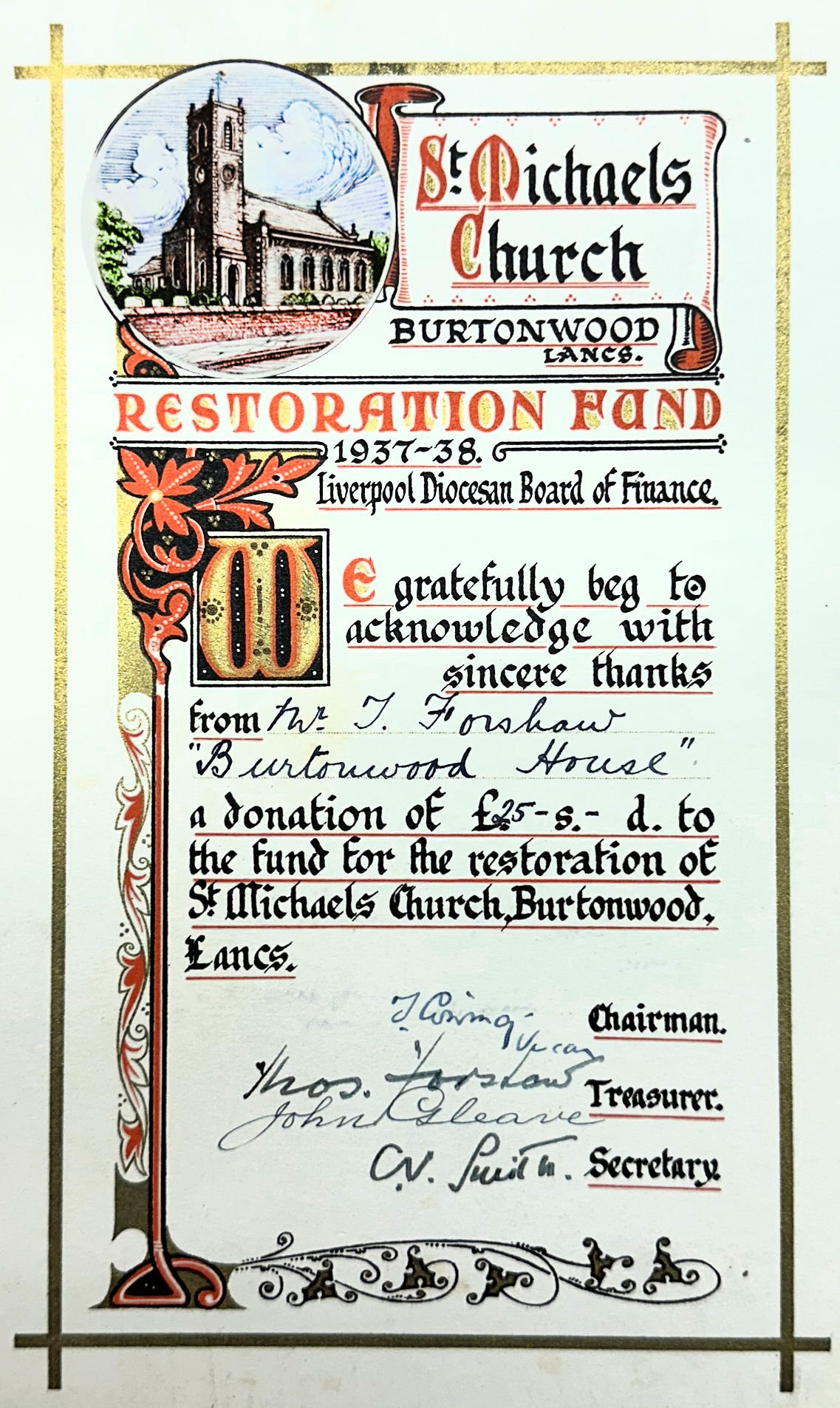
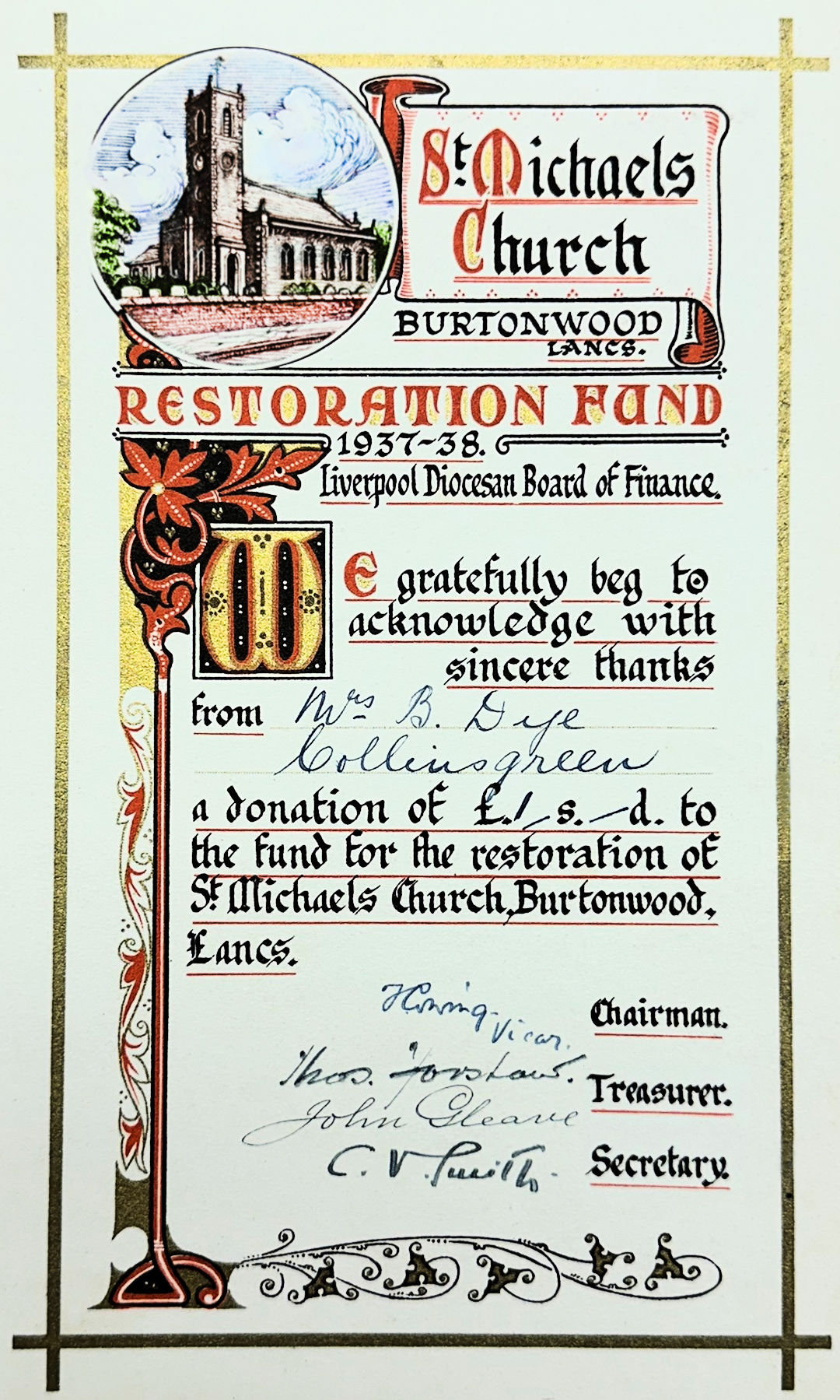
BEWSEY — BURTONWOOD 1210—1588.
Burtonwood means fortified Manor in a wood.
Bewsey means beautiful site.
Dallam means Valley Meadow.
Henry V.
1170. Thomas à Beckett, Archbishop of Canterbury, had some kinship with the Boteler family through Theobold Walters, a great Lancashire nobleman.
John.
1210. William le Boteler, 6th baron of Warrington, accompanied King John to Ireland, he also witnessed the granting of the first charter to the Burgesses of Liverpool by King John.
Henry III.
1225. William le Boteler rebuilt St. Elphin’s Church, Warrington.
1251. Earl de Ferrars secures free warren in many of his Lancashire Manors including burtonwood.
1256. Sir William Boteler, 7th baron, built Manor House of Bewsey.
1258/9. The site for Bewsey Hall was granted by Earl William de Ferrars.
1260. Sir William Boteler was High Sheriff of Lancashire.
Sir William le Boteler obtained from Earl Wm. de Ferrars grant of all his hey or enclosure of Burtonwood with venison in all the Earl’s woods and lands in Burtonwood.
1264. Sir William le Boteler with Earl Wm. de Ferras at Battle of Lewes.
1270. Prince Edmund, Earl of Lancaster, second son of Henry III, describes Sir William le Boteler, Baron of Warrington, Lord of the Manor of Burtonwood, his “beloved and faithful servant.”
The Prince granted Sir William his acquittance of 105 marks in part of 900 marks for the purchase of Burtonwood and woods of Burtonwood.
Edward I.
1277. Sir William Boteler fought in the Welsh wars with Edward I, who had a meeting with Sir William at his Castle on Mothelhill, Warrington, before his offensive against the Welsh, the King commanding all his bailiffs and others to aid Sir William, who was Commander of the King’s Northern forces.
1282. Sir William le Boteler was present when the first Prince of Wales was presented to the Welsh Chieftains at Caernarvon. Sir William died 1291.
Edward II
.
1303. Sir William le Boteler, 8th baron, marched his men to join the King at Berwick against the Scots.
Edward III.
1337. Sir William Boteler commanded to raise 1,500 archers and march with them to Scotland.
1342. Sir William in war in Brittany.
1346. Sir William le Boteler was present at the Battle of Crecy with the Black Prince, Lancashire men being famous Archers.
1352. Henry, Duke of Lancaster, grandson of Edmund, was superior lord to Boteler, Henry’s daughter Blanche married John of Gaunt, who later became Boteler superior lord of Manors of Warrington and Burtonwood.
1357. Sir William le Boteler and his son John were in the retinue of Prince Henry of Lancaster before Poitiers.
1371. Sir John Boteler, 10th baron, was in John of Gaunt, Duke of Lancaster’s retinue in the expedition to Gascony.
1372. With Gaunt and the Black Prince when they crossed the Pyrenees and gained the great victory at Navalette.
1373. Sir John, High Sheriff of Lancashire.
Richard II.
1386. Sir John again with Duke of Lancaster in Castile.
1393. Sir John founded Chantry of St. Elphin’s Church, Warrington.
Henry IV.
1399. Sir William Boteler, 11th baron, was made a K.B. at the coronation of King Henry IV, the King being Duke of Lancaster.
Henry V.
1415. Sir William Boteler died during siege of Harfleur, brought back to England and buried in Warrington Church. John le Boteler fought at Agincourt, knighted and later usher to the Court of Henry V.
Henry VI.
1459. Sir John Boteler, 13th baron at the Battle of Bloreheath, his wife was Margaret, sister of Thomas, second Lord Stanley, head of the house of Latham.
Edward IV.
1475. Sir Thomas Boteler, 14th baron, was in Lord Stanley’s retinue in France.
1482. Sir Thomas Boteler present when Lord Stanley took Berwick Castle.
Richard III.
1485. Sir Thomas Boteler, 15th baron, with Lord Stanley at Bosworth, when Richard III was killed and Henry of Richmond crowned Henry VI.
Henry VII.
1495. The King decided to visit Bewsey Hall and Sir Thomas Boteler on his way to stay with Lord Derby.
Henry VIII.
1513. Sir Thomas Boteler at the Battle of Flodden Field.
1523. Sir Thomas Boteler, 16th baron, Constable of Lancaster Castle.
1526. Sir Thomas founded Warrington Grammar School.
1534. High Sheriff of Lancashire.
1537. Sir Thomas, 17th baron, was appointed keeper of all the King’s manors, castles and lands in Lancashire.
BEWSEY — BURTONWOOD
1586—1939
Elizabeth.
1586. Earl of Leicester, Lord of Manor of Bewsey. His wife was great niece of Ann Boleyn, he himself being a favourite of the Queen.
1588. Ambrose Dudley, Earl of Warwick, succeeded his brother, Leicester, was General of Ordnance to Queen Elizabeth during the Spanish Armada; he was Lord of Manor of Burtonwood.
1590. Robert Dudley succeeded.
1595. Robert Dudley fitted out three ships and took Trinidad.
1596. Sir Robert Dudley was knighted at the taking of Cádiz.
1597. He sold Bewsey Estates to Richard Bold and Thomas Ireland.
1597. Thomas Ireland came into possession, descended from Irelands of Hutt and Hale.
1602. Thomas Ireland, Lord of Bewsey.
James I.
1617. The King stayed at Bewsey, where Thomas Ireland was knighted.
Sir Thomas’s daughter married John Jeffreys, father of the famous Judge Jeffreys; this daughter died at Bewsey 1661.
1625. Sir Thomas married Margaret, daughter of Sir Thomas Stanley of Alderley.
Charles I.
1634. Thomas Ireland present at Consecration of Burtonwood Church, died 1639. Several of the Stanley’s of Alderley present at his funeral.
1638. Margaret Ireland married 1646 her kinsman, Gilbert Ireland.
1643. Provisions were stored by the Royalists at Bewsey during the Civil War.
Cromwell.
1648/9. Gilbert Ireland, High Sheriff of Lancashire.
1654. Gilbert Ireland made Colonel, also M.P. during the Commonwealth.
1655. Gilbert Ireland was Governor of Liverpool, and in 1658 was equerry at Cromwell’s funeral.
Charles II.
1661. Gilbert Ireland Knighted by the King.
1673. Sir Gilbert Ireland Deputy Lieutenant of Lancashire, 1674 Mayor of Liverpool, left issue, one daughter Elinor, who married John Atherton.
1675. Richard Atherton, son of John Atherton.
1684. Richard Atherton, Mayor of Liverpool. Judge Jeffreys, Chief Justice of England, visited Bewsey, where he met the Mayor and sixteen members of the Corporation, who submitted their Charters to him. The Corporation received new charters back from Sir Richard who had been knighted at Windsor by the King.
James II.
1688. John Atherton, Lord of Manor of Bewsey.
Ann.
1707. Richard Atherton, Lord of Manor of Bewsey, his only daughter Elizabeth married Robert Gwillynn in 1738.
George III.
1760. Bonnie Prince Charlie visited Bewsey Hall in the last attempt to raise his standard.
1763. Robert Vernon Atherton Gwillynn married Henrietta Maria, eldest daughter of Peter Legh of Lyme.
1774. Member of Parliament for Newton up to 1780.
1783. Henrietta Maria Atherton, only daughter, is owner of Bewsey.
1797. Married Honorable Thomas Powys, eldest son Thomas, Lord Lilford.
George IV.
1825. Honorable Thomas Atherton Powys, eldest son Lord Lilford, becomes Lord of Manor of Bewsey, his brother, Honorable Right Reverend Horace Powys, was Rector of Warrington and later Bishop of Sodor and Man.
1939. The Right Honorable Lord Lilford is the Lord of the Manor of Bewsey.
BRADLEY — BURTONWOOD
Bradley means broad, lea or meadow
Henry V.
1415. Sir Piers de Legh of Lyme, Bradley and Haydock, wounded at Agincourt.
Henry VI.
1460. Sir Piers de Legh fought at Battle of Wakefield, when he was knighted, and at Battle of Towton 1461.
Edward IV.
1461. Constable of Rhuddlan Castle.
1478. Sir Piers died at Bradley Hall, which he had rebuilt.
1482. Peter Legh of Bradley, Lyme and Haydock, was present when Lord Stanley took Berwick Castle. Peter, being knighted, fought at Hutton Field. Richard, Duke of Gloucester, afterwards King Richard III, visited and stayed at Bradley Hall on his way to, or returning from the taking of Berwick Castle.
Sir Piers’ son, Gowther Legh, founded the free Grammar School at Winwick.
Sir Piers Legh, after losing his wife, became a priest, and was buried at Winwick. His brother-in-law was Archbishop of York.
Henry VIII.
1527. Sir Piers Legh, who died this year, had founded the chantry at Winwick Church.
1541. Piers Legh died at Bradley.
1544. Sir Piers Legh knighted at Leith.
Edward VI.
1551. Sir Piers Legh was High Sheriff of Lancashire.
Mary I.
1554. Sir Hugh Cholmondeley was High Sheriff of Cheshire; died 1598.
Elizabeth.
1590. Peter Legh, M.P. for Wigan, High Sheriff of Cheshire.
1598. Peter Legh Knighted at Greenwich, married Jane, daughter of Sir Thos. Gerard. Served with Earl of Essex in two expeditions to Spain, present at taking of Cadiz 1596 by Sir Walter Raleigh. Kept up his house at Bradley; his daughter Ann married Richard Bold.
Charles I.
1636. Sir Peter died.
Charles II.
1659. Richard Legh, M.P. for Chester, still holds Bradley Hall.
1660. Richard Legh M.P. for Newton, buys Newton Estates, and becomes Baron of Newton.
1662. Richard Legh made Deputy Lieutenant of Lancashire.
James II.
1687. Richard Legh died, buried at Winwick.
George II.
1745. Peter Legh of Lyme succeeded to the Estates of Lyme, his daughter Henrietta Maria married Robert Atherton Gwyllym of Bewsey, from whom descended present Lord Lilford.
The Right Honorable Lord Newton is now the head of the ancient family of Legh.
BOLD AND BURTONWOOD.
The Bold Family resided in Bold before Edward the Confessor.
Henry III.
1254. Earl Wm. de Ferrars granted William Bold the whole Manor from Bewsey, Burtonwood, including Haley Head Manor Farm of Burtonwood.
Henry IV.
John de Bold and his son Thomas Bold fought with Henry, Prince of Wales, later Henry V, against Owen Glendower. John was knighted.
1403-1404. Sir John Bold—Constable of Caernarvon Castle, in command of garrison of 20 men-at-arms and 80 archers.
1404. Sir John de Bold received licence from the King to em-park 5,000 acres of land in Bold.
1406. Sir John de Bold founded the Chapel at Farnworth.
1407. Sir John, High Sheriff of Lancashire from 1407-1410.
Henry V.
1415. Thomas Bold fought at Agincourt.
Edward IV.
1461. Sybella Bold, daughter of Henry Bold, married Sir Alexander Standish.
Henry VII.
1508. Sir Baldwyn Bold, priest at Farnworth Church.
Henry VIII.
1532. Sir Richard Bold died; he married Margaret, daughter of Sir Thomas Boteler.
Elizabeth.
Richard Bold, Sheriff of Lancashire 1576-1590.
1597. Bewsey Estates bought by Richard Bold and Thomas Ireland.
James I.
1605. Sir Thomas Bold gave the site for Burtonwood Church, married daughter of Sir William Norres of Speke.
1612. Sir Thomas died, held Manors of Bold, Burtonwood, Sutton, Great Sankey and North Meols, amounting to 31,000 acres.
Richard Bold married Ann, daughter of Sir Piers Legh of Lyme, Bradley and Haydock, 1616, restored Old Bold Hall; his name and his wife’s on a tablet over the doorway.
1631. Richard Bold, High Sheriff of Lancashire, died 1636.
1634. Richard Bold present at consecration of Burtonwood Church.
1636. Richard Bold, cousin of Richard and son of William Bold, succeeds.
Cromwell.
1654. Peter Bold, High Sheriff of Lancashire, died 1658.
William III & Mary II. Peter Bold, son of Peter Bold, High Sheriff of Lancashire, died 1691.
1690. Peter Bold succeeds.
George II.
1727. Peter Bold, M.P. for Wigan up to 1734, died 1761. The last male member of the family leaving seven daughters, co-heiresses.
George III.
1761. Anna Maria became Lady of the Manor of Bold, also joint Lady of the Manor of North Meols with her nephew Bold Fleetwood Hesketh, Esq., of Rossall, died 1813, aged 82, succeeded by her nephew Peter Patten Bold.
1773. Dorothea Bold married Thomas Patten of Bank Hall, Warrington, Sheriff of Lancashire, Lieutenant-Colonel Royal Lancashire Militia.
1814. Peter Patten Bold, Deputy Lieutenant of Lancashire during Peninsular War.
1819. Peter Patten Bold died. Peter Patten Bold succeeded, M.P. for Walmesbury, Colonel 5th Regiment Lancashire Militia, left two daughters.
Dorothea Patten Bold succeeded to the Estate, married 1813 Henry de Hoghton, eldest son of Sir Henry de Hoghton, became Sir Henry Bold Hoghton, who was lord of Manor of Bold and Burtonwood.
George IV. Sir Henry Bold Hoghton, Deputy Lieutenant of Lancashire, Colonel 3rd Royal Lancashire Militia; his wife Dorothea died 1840; from this union descended Major Blackburn Ireland.
Victoria.
1859. Sir Henry sold the Bold Estate piecemeal, and the Lyon family purchased part of these, amongst which was Haley Head Farm, and became Lord of the Manor. Lieutenant-Colonel Charles Lyon is now Lord of the Manor of Burtonwood.
Descendants of the Bold Family
George II.
Margaret Bold, a younger daughter, married Hugh Owen of Penrhos, their only daughter Margaret married Sir John Thomas Stanley of Alderley, father of the first Lord Stanley.
Dorothea Bold, second daughter of Peter Bold, has descendants Lord Suffield, Tuanton Park, Norwich; Sir Roger Lumley, G.C.I.E., D.L.E.E., Lumley Castle, Durham; Right Honorable Lord Churston, Lupton House.
Francis Bold, third daughter of Peter Bold, married Fleetwood Hesketh, Esq., North Meols Hall, from whom is descended Peter Fleetwood Hesketh, Esq., Meold Hall, Southport.
Mary Bold, fourth daughter of Peter Bold, married Thomas Hunt, Esq., of Mallington, from whom is descended Right Honorable Viscount Clifton, Sandydrock, Cornwall.
Charles II.
1673. Jane Bold, daughter of William Bold, married William Meyrick, from whom is descended Sir George Meyrick of Bodorgan, Anglesey.
ST. MICHAEL’S, BURTONWOOD.
LIST OF SUBSCRIBERS.
The completion of the Restoration and Enlargement of the St. Michael Church would not have been possible except for the generosity of the following subscribers:
Mrs. J.D. Anders, Mr. J.H. Anders, Mr. and Mrs. J. Addison, Mrs. A. Addison, Mrs. A. Atkin, Mr. J. Anders, Mrs. M. Anders, Mr. and Mrs. John Addison, Anonymous, Mrs. E. Astley, Mrs. J. Ash, Mr. Astley.
Messrs. Broad Lane Estate, Co., Messrs. Burtonwood Motor & Aircraft. Eng. Co., Ltd., Burtonwood Boys’ Brigade, Major G. J. Ireland Blackburn, Miss Baguley, Mr. & Mrs. J.E. Baxter, Burtonwood Dahlia Queen Committee, Mr. & Mrs. F. Brown, Mr. & Mrs. Bamber, Miss Baron, Mrs. Frank Bamber.
Mr. W. Cooper, Messrs. T. Charlson, Son & Co., Ltd., Mr. T. C. Butler Cole, Rt. Hon. Lord Viscount Clifden, Collins Green Colliery Co., Ltd., Mr. Brian Cowing, Miss Shirley Cowing, Mr. Barry Cowing, Rev. & Mrs. T. Cowing, Mr. & Mrs. J. Cook, Mrs. Carter, Mrs. Cook, Mr. & Mrs. R. Cooper, Mr. Stanley Cooper, Mrs. Conman.
Mrs. S. A. Ditchfield, Mrs. Duncan, Mr. & Mrs. W. Dean, Mr. & Mrs. M. A. Darbyshire, Mrs. D. M. Duxbury, Mrs. A. Darbyshire, Mrs. Davies, Mr. & Mrs. F. Dodd, Mr. & Mrs. Dallas, Mrs. B. Dye, Mrs. Dowd.
Mrs. C. Forshaw & Family, Mrs. T. Forshaw, Mr. T. Forshaw, Mr. J. Forshaw, Mr. Richard Dutton Forshaw, Mr. N. Fairclough, Mr. H. Fairclough, Mr. J. Fairclough, Mr. J. Fairclough, Mr. G. Ford, Misses S. & B. Forshaw, Mrs. M. J. Finning, Mrs. S. E. Forster, Miss F. Fairclough, Farmers & Dancers (Mr. F. Fairclough).
Mr. E. Fairclough, Mr. & Mrs. R. Fairclough, Mr. & Mrs. W. Forshaw, Mrs. R. Fairclough, Mr. & Mrs. J. Fairclough, Mr. & Mrs. Fletcher, Mr. & Mrs. H. Flint, Miss E. Fairclough, Miss Fisher, Mr. & Mrs. Fisher, Mr. & Mrs. Farnsworth, Miss E. Fearnley, Mrs. J. A. Gilchrist, Mr. J. A. Gilchrist, Miss M. F. Cough, Mrs. Cleave & Family, Mrs. Greenhalgh, Messrs. Greenall, Whitley & Co., Mr. E. Gordon, Mr. T. Gordon, Mr. W. Garner, Messrs. D. Grundy, Mr. G. Garner, Mr. R. Garner, Mr. W. R. Greenwood, Mr. W. Greenwood, Miss Irene & Mr. Albert Greenwood, Mrs. Greenwood, Mr. Gilchrist.
Mr. P. Fleetwood Hesketh, Mrs. Hayes & Family, Mr. H. Helsby, Misses S. & J. Houghton, Miss A. Haslam, Mrs. Francis Houghton, Mr. & Mrs. A. Houghton, Mr. & Mrs. G. Hope, Mr. & Mrs. N. High, Mr. & Mrs. Highcock, Mr. & Mrs. M. Heyes, Miss E. Hayes, Miss A. Hayes, Mr. & Mrs. J. S. Hodson, Mr. & Mrs. L. Hughes, Mr. & Mrs. R. Holland, Miss E. Holcroft, Mr. & Mrs. F. H. Hancock, Mr. & Mrs. R. Heyes, Mr. H. Heyes, Mrs. M. Heyes, Mrs. Halliwell, Mr. J. Hewitt, Mrs. A. Hughes, Mr. Wm. Jonathan Hosker, Mr. W. Hewitt, Mr. & Mrs. D. H. Hewitt, Mr. Frank Hatton.
Mr. & Mrs. R. Jackson, Mr. & Mrs. J. Jones, Mr. J. D. Jones, Mr. & Mrs. T. Jones, Mr. & Mrs. D. Jones, Mr. & Mrs. P. Jones.
Mr. J. Kynaston, Mr. A. Kilshaw, Mr. & Mrs. P. Knowles, Mr. A. Kilshaw, Mr. & Mrs. T. Kerrigan, Mr. & Mrs. J. Kelsall, Miss J. Kelsall, Mr. & Mrs. J. Kay.
Right Honorable Lord Lilford, Sir Roger Lumley, C.C.I.E., Messrs. Lewis Bors, Colonel Lyon, Mr. A. Lythgoe, Mr. W. S. Longton, Miss B. Layland, Mrs. Elizabeth Layland, Mrs. F. Lloyd, Mr. & Mrs. Leatherbarrow, Mrs. E. A. Lawrence, Mrs. O. Lomax, Mr. & Mrs. Lyon, Mrs. E. Lacey.
Miss W. Mitchell, Mr. McKinnell, Mrs. & Misses Mitchell, Mr. & Mrs. W. Major, Mrs. S. Mathews, Mr. & Mrs. Mitchell, Mrs. S. A. Mimmack, Mr. & Mrs. Marsh, Mr. & Mrs. W. McCourty, Mr. & Mrs. Molyneux, Mrs. McKinnell, Mr. & Mrs. Morris, Mr. & Mrs. McKee.
Mr. T. Norcott, Mr. W. Norcott, Mr. & Mrs. G. Neville, Mr. F. Noonan, Mr. W. P. Norcott, Rt. Hon. Lord Newton, Mrs. Naylor, Mr. F. E. Naylor, Mr. & Mrs. R. E. Naylor, Miss A. J. Naylor, Miss J. Naylor, Mr. & Mrs. J. H. Naylor.
Mr. R. Parker, Mrs. Pierpoint, Mrs. M. E. Pratt, Mr. L. E. Pilkington, Penrose Estate (Mr. Stanley), Mr. & Mrs. A. Powell, Mr. & Mrs. J. Pennington, Mrs. Pennington, Mr. & Mrs. H. Potter, Mr. & Mrs. J. Pennington, Mrs. Plumpton, Mr. & Mrs. M. J. Pickersgill, Mr. & Mrs. M. Pickersgill, Mr. E. P. Pickersgill, Mrs. A. Pickering.
Mr. Richardson, Mr. A. Rabjohns, Mrs. A. Roberts, Mr. & Mrs. H. Roberts, Mrs. Zee Remmels, Miss Sylvia Rimmer, Mr. & Mrs. R. Roberts, Mr. T. Roberts, Mr. & Mrs. Reynolds, Mr. W. T. Roberts, Mrs. J. Roberts, Mr. & Mrs. Rapson, Mrs. D. Roberts, Miss J. Roberts.
Mr. C. G. Sutton, Mr. & Mrs. H. Singleton, Mrs. L. Spurling, Mr. L. Spurling, Mr. G. Spurling, Mr. C. W. Schofield, Mrs. Shaw, Master K. Simm, Mr. C.V. Smith, Mr. T. Stone, Rt. Honorable Dowager Lady Suffield, Mr. & Mrs. R. Siddley, Mr. T. & R. Shaw, Messrs. Silcock & Sons, Mr. & Mrs. C. Singleton, Mrs. Shaw, Mr. & Mrs. A. Seddon, Mr. Thos. Shaw, Miss M. Smith, Mr & Mrs. Spurling, Mr. Llew. & Alice Spurling, Mr. & Mrs. Wm. Spurling, Mr. & Mrs. A. Smith, Miss M. Southern, Mr. N. A. Southern, Mr. John Simms, Mrs. J. Simms, Mrs. J. Simms, Mr. G. Spurling, Mrs. M. Shaw, Mrs. B. Southern, Mr. Richard Shaw, Miss J. Shaw, Mr. Peter Shaw, Alan & David Smith, Mrs. M. Swallow, Mrs. T. Southern, Mr. T. Southern, Mr. P. Smith, Mrs. P. Smith, Mrs. C. V. Smith.
Mr. H. Thorn, Mr. & Mrs. Thomas, Mrs. W. Taylor, Mrs. H. Taylor, Mrs. R. Taylor, Mrs. Tither, Mrs. J. Tinsley.
Dr. Valentine.
Mr. J. Webb, Mr. W. Webster, Mr. J. B. Williams, Mr. & Mrs. J. Welsby, Mr. R. Welding, Mr. & Mrs. A. Welding, Miss Clarice Welding, Mr. Daniel Welding, Mrs. F. Wright, Misses M. & E. Wright, Mr. & Mrs. B. Welding, Mr. R. O. Welsh, Misses A. & B. Whitehead, Mr. & Mrs. W. Welding.
Right Honorable Sir Robert Young, M.P.
This history of Burtonwood and St Michaels has been transcribed by Steen Dowd from original documents held in Chester Records Office
